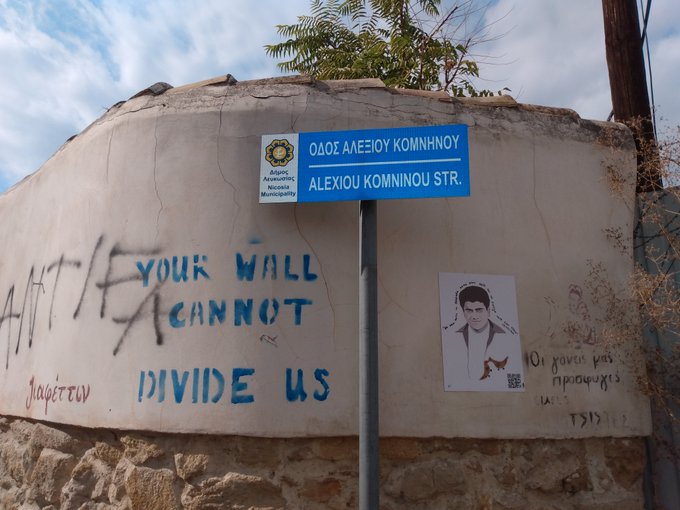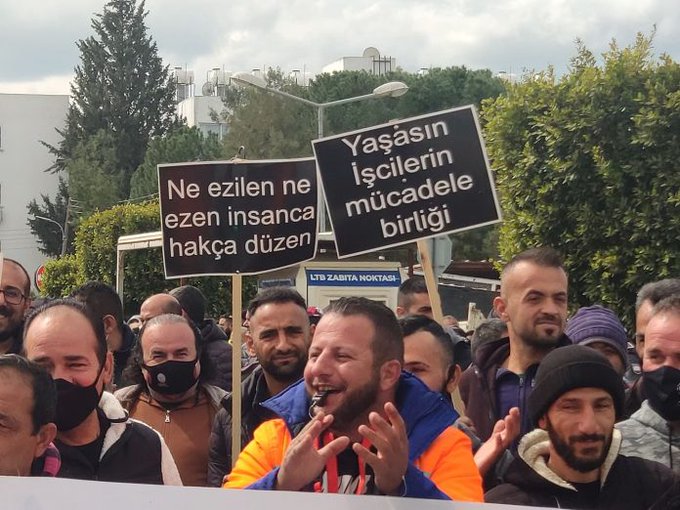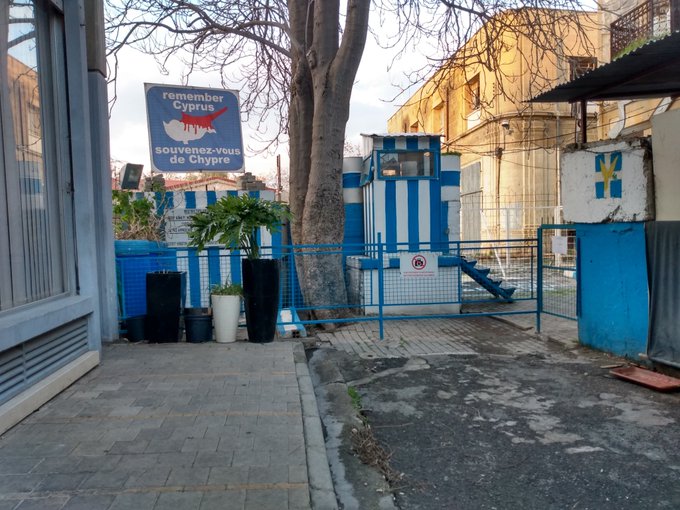Almost Five Decades Later in Cyprus: Everything Has Changed, And Nothing Has Changed
In October and November 2022, a group of University of Tartu students undertook a research trip to Cyprus with the aim of discovering the contemporary challenges of the long-running conflict, considered one of the longest yet most peaceful enduring conflicts. Partially settled by a de facto division of the island between the internationally recognised Republic of Cyprus (RoC) and the unilaterally independent Turkish Republic of Northern Cyprus (TRNC), the situation has evolved into a stable status quo which even sees regular daily commutes between the Northern and Southern sides of the divided capital, Nicosia. This city was the base for the research trip to uncover the reasons behind the enduring stalemate, despite an official commitment from both sides to the eventual reunification of the island. This blog begins by comparing the experience on both sides of the dividing line, before examining the perspectives on reunification and why this settlement remains elusive.
What is most remarkable about the divided capital is how busy life is on either side of the checkpoint, and yet simultaneously both an asymmetrical reflection of the other. On the Southern side, despite the main thoroughfare towards the Ledra Street Checkpoint bustling both day and night, the buildings along the Buffer Zone itself are rather more sombre. Abandoned, adorned with graffiti, these narrow streets are a stark contrast to the life that populates the restaurants. Aside from some of the buildings immediately along the Buffer Zone, the Old Town is reasonably well-preserved, but the real development begins as the Old Town ends and the sprawling suburbs of Nicosia begin, complete with Mediterranean villas and a modern University campus towards the edge of the city.
On the other side, the story is the opposite. Visitors are greeted on the other side by lively stalls advertising various goods in Euros – not the official Lira. A façade of success, and a certain tourist trap if ever there was one. Moving further away from the checkpoint, the evidence of life in the grey zone becomes clear, with buildings falling into disrepair around the initial tourist hit. The investment in tourism in the North is physically evidenced by obviously out of place buildings – a brick and mortar British-style pub and boutique hotel sandwiched by peeling concrete buildings advertising an endless supply of lawyers; or a high-end Italian-inspired restaurant, complete with an indoor fountain, across the road from the rather modest Presidential ‘palace’, a small complex of houses which are more in keeping with the surrounding neighbourhood’s low profile.
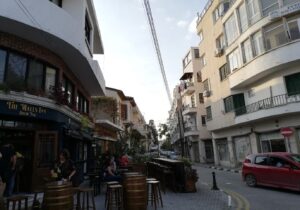
Image: A new craft beer pub opposite old, abandoned shops (Source: Adam Ziogas)
This raises the rather obvious question of the viability of the North today. Reliant on tourism, particularly from those proud to claim to have been to a country that does not exist, and who do not venture beyond the artificial ‘Euro-zone’, there is a need for a sustainable life for the citizens of the North, who for example receive differentiated treatment at the border crossing, which is divided between ‘Turkish Cypriots’ and ‘Cypriot, EU, and third country passports’ as one category of all others. In its bid to attract more tourists, the North has fashioned itself as a Turkish Las Vegas, which has some interesting consequences. The first is that outside the divided Old Town of Nicosia, mainly for Western tourists crossing from the South, the other cities of the North have a lot of money pumped into hyper-modern developments, shiny hotels and casinos which rise from the desert and stand in stark contrast to the dilapidated apartment blocks in which people live. The second is that the TRNC is idealised as a freer Turkey – gambling is legal, and the port town of Kyrenia resembles less a conflict zone than a Turkish Monaco. This raises the rather troubling question of the role of Turkey in the conflict and the agency of Turkish Cypriots who have very much faded from public view in a would-be state whose viability is reliant on attracting internationals who bring their own ideas and interests.
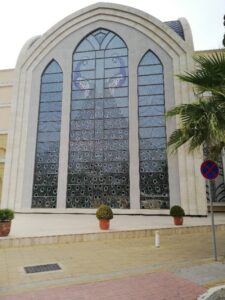
Image: The gaudy window of one of the hotels in Kyrenia (Source: Adam Ziogas)
However, the North is not alone in demographic changes. The most important take-away from this research trip has been the diversity of the population on the entire island. The South in many ways resembles many other European societies, with a large influx of immigrant workers. It is a similar story in the North whose economy relies on international students and foreign visitors. As such, this gives the whole island a surreal feel as discussion focuses on the dichotomous Greek/Turkish Cypriot communities, but today what is evident is the parallel development of two separate societies. Not ethnic communities, but whole societies with new emerging interests, but each problematically founded on an opposition to their counterpart. Neither can survive without the other as their essential raison d’être. This means in many places it is impossible to avoid the feeling of being in a Potemkin village. Public spaces are open places of historical memory whose role is to reinforce the narratives being promoted – be it via a plethora of flags or statues commemorating various figures and events from the historical narratives of each side. Yet the human face, the people, the Cypriots, both Greek and Turk, have faded into the background as each side has developed independently over the past decades.
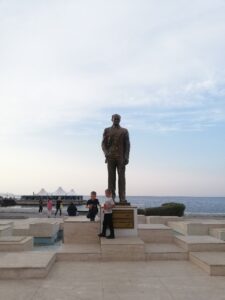
Image: Children play with Atatürk by the seaside (Source: Adam Ziogas)
In this way, both have managed to create parallel societies on either side of the diving line, both of which have in their own way moved beyond the historicism of the conflict, which lives on largely in symbolism: Greek flags alongside every RoC flag which line the Buffer Zone, obscenely large TRNC and Turkish flags side-by-side on various buildings throughout Northern Nicosia. What differs between the two sides is that away from the symbolic Nicosia, Greek flags gradually disappear, but in the North Turkish and TRNC flags line streets in an open and unashamed nationalist drive. Catering perhaps less to the Turkish Cypriots and more to the many Turks who idealise the TRNC. Today, then, faced with evolving societies, we must answer the question to what extent these old dividing lines are still relevant, and as such, can we continue to use the old frameworks of the conflict and its potential solutions to limit our vision of the future?
These themes came through in our discussions with local academics in the South which emphasised a society paralysed by the conflict. Despite the relative peace and stability, everything is seen through the lens of the ‘Cyprus problem’, which means a convenient political stability which is reluctant to give up its strong established narratives and is incapable of engaging with other emerging social issues which compete with the ever-present division which defines life on the island. This creates a certain tension in the South as the strong public discourse has indoctrinated the youth to an extent that the new generation appear more hard-line than their predecessors who, despite living through the conflict itself, remember a time before and inter-ethnic friendships. However, the demographic changes represent a new momentum as Nicosia’s lampposts are decorated with anti-fascist and anti-racist stickers and graffiti in support of the marginalised migrant community. Whether this could unblock the traditionally dichotomous conflict remains to be seen.
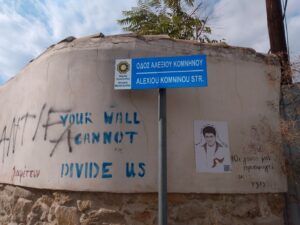
Image: An anonymous call for a change (Source: Eiki Berg)
Nevertheless, the conflict is so ingrained in the Greek Cypriot community that it is lived on multiple levels which impedes any resolution. While the macro political situation remains at an impasse long determined by predefined ethnic interests and red lines, on the micro level it is all about individual survival. While some search for personal justice, others are more than ready to profit from the irregularity of their situation – especially in the villages of the Buffer Zone where the informal economy reigns supreme. Division rules the island to such an extent that for many who profess a desire for reunification, there is an unmistakeable ability to manage perfectly well with the status quo – and perhaps that, rather than any political impasse, is the reason between the conflict’s endurance.
In discussion with academics from the North, a different picture emerges. Rather than a focus on the political impasse, there was a strong focus on the changes on the island over the course of the decades-long conflict. While it has remained frozen and unresolved, changes have swept the North which has shifted the priorities of its citizens and complicated the question of settlement. Following the EU accession of the RoC, the internationally recognised and EU passport has attracted a number of young Turkish Cypriots who now look to Europe for their education and future prospects, where their parents once looked to Turkey. This has a number of implications, the first being the brain drain afflicting the TRNC as young people move away from the uncertainty of the future of their de facto state. This also underscores a certain understanding that Turkish Cypriots belong to Europe as they feel able to pursue their future there. However, this might have difficulty in translating into a breakthrough in the conflict as this is a largely individualistic tendency and does not contribute to the convergence of the two communities on the island.
The shifts in education also begin to reveal a difficult relationship with Turkey. Many Turkish Cypriots are wary about an overreliance on Turkey, who is, like many other states and governments, more concerned with its own interests than those of the Turkish Cypriots. While the Presidential office is currently an outwardly modest building, Turkey is funding the construction of a külliye to house a new Presidential palace and parliament for the TRNC. On the one hand, this lavish spending clashes with the isolated reality that ordinary Turkish Cypriots experience, and on the other it is also a demonstration of the nuanced cultural difference between Turkish Cypriots and the Turkish ‘motherland’. Whereas Erdoğan has begun openly promoting Islam in Turkey, Turkish Cypriots regard religion more as a private affair. Hence the TRNC also attracts many young Turks as it represents essentially a smaller, freer, more liberal Turkey.
In the North the political elite face the challenge of negotiating their existence with the South, as well as justifying Turkey’s invaluable support for their survival. However, the general public is less pro-Turkey and has its own interests which are lost at the negotiating table. The TRNC authorities take an uncompromising pro-Turkish stance, vehemently denying any Cypriot national identity. How they propose to deal with their population who would like to see the island reunited is unclear. This is further complicated by the demographic changes outlined earlier. With many Turkish Cypriots moving away from the TRNC for education and work, new populations coming to fill the gaps in employment, and a large influx of international students who may choose to stay or bring their families, does it really make sense to continue to prolong the basic ethnic narratives from the 1960s?
This divide between politics and the public is a common thread on both sides of the island. The South is afflicted by growing political apathy due to an inefficient political apparatus which has the Cyprus problem as its only priority and lens for approaching all political challenges. This risks stagnating the development of the South as social problems are not adequately addressed. Nevertheless, due to their dominant position there is the risk in the RoC of too much comfort allowing dangerous narratives to survive and prosper, seen in the more radical views of the youth compared to their predecessors. This is evidence once again of a society built on opposition, and a conflict which cannot be resolved as any solution fundamentally challenges the very basis of the state as it defines itself.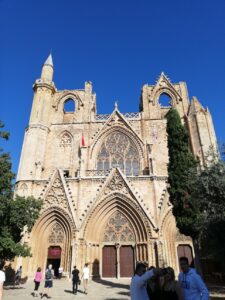
Image: Old and new: a distinctive Gothic Church converted into a Mosque (Source: Adam Ziogas)
The big question hanging over Cyprus is one of reconciliation. Even in promoting their new preference for a two-state solution, the TRNC authorities hope for neighbourly relations, which while not reuniting the island would still require a major step down in rhetoric from both sides and reconciliation between the populations and the political elites. However, what is striking is the total lack of official reconciliation initiatives. Any initiatives are run almost entirely by NGOs, with little to no government support from either side. In this context, while these initiatives are certainly brave and responsible efforts, there seems to be little point if the political discussion is absent and refuses to move on. The fact is that the education systems remain a tool of government narratives and without broader island-wide reconciliation efforts people have no need, no impetus, and no opportunity to actually engage with the Cyprus problem. People remain in closed circles of acquaintances and communities from which they cannot and indeed do not need to escape.
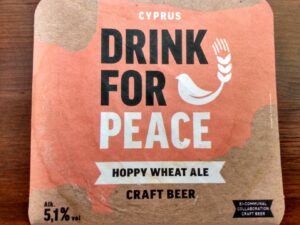
Image: One of the few bi-communal collaboration efforts (Source: Eiki Berg)
The fact of the matter is that the conflict is politically convenient. Driven by a basic understanding of us and them, more is achieved, both positive and negative, through unilateral action, and there is simply no bilateral discussion. Especially today, with Turkish-installed hardliners in charge in the TRNC, and a RoC who refuses to engage with the TRNC out of a perpetual fear of indirect recognition. The irony is that this approach has foiled moderates of the TRNC and failed Turkish Cypriots as at the political level the TRNC has fallen further under Turkey’s thumb.
The window of opportunity for reunification is fast closing, if it has not already. Over the past almost six decades since the Constitutional crisis, almost five decades since the events of 1974, and almost four decades since the TRNC’s unilateral declaration of independence, everything has changed, and nothing has changed. Two parallel societies have developed, and it is more and more difficult to perceive a future together as each day passes. Yet the political debate on the island remains trapped by the dream of one island and the convenience of an eternal issue which distracts from more basic questions of good and effective governance. These two dynamics, developing societies and rigid political narratives mean that there is little to no hope of any settlement. There is no discussion, no creative ideas, no bravery to put forward a solution. It is purely a game of survival, where each regime ensures its longevity by maintaining the conflict and thus stabilising their status vis-à-vis their Other, eternally stabilising instability.
Author: Adam Ziogas


